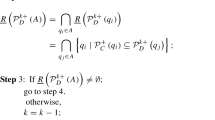Abstract
We consider a problem of decision under uncertainty with outcomes distributed over time. We propose a rough set model based on a combination of time dominance and stochastic dominance. For the sake of simplicity we consider the case of traditional additive probability distribution over the set of states of the world, however, we show that the model is rich enough to handle non-additive probability distributions, and even qualitative ordinal distributions. The rough set approach gives a representation of decision maker’s time-dependent preferences under uncertainty in terms of “if…, then…” decision rules induced from rough approximations of sets of exemplary decisions.
Similar content being viewed by others
References
Allais, M. (1953). Le comportement de l’homme rationnel devant le risque; critique des postulats et axioms de l’école américaine. Econometrica, 21, 503–546.
Artzner, P., Delbaen, F., Eber, J., & Heath, D. (1999). Coherent measures of risk. Mathematical Finance, 9, 203–228.
Bøhren, Ø., & Hansen, T. (1980). Capital budgeting with unspecified discount rates. Scandinavian Journal of Economics, 82, 45–58.
Borgonovo, E., & Peccati, L. (2009). Financial management in inventory problems: risk averse vs risk neutral policies. International Journal of Production Economics, 118, 233–242.
Ekern, S. (1981). Time dominance efficiency analysis. Journal of Finance, 36, 1023–1034.
Ellsberg, D. (1961). Risk, ambiguity, and the savage axioms. Quarterly Journal of Economics, 75, 643–669.
Epstein, L., Marinacci, M., & Seo, K. (2007). Coarse contingencies and ambiguity. Theoretical Economics, 2, 355–394.
Fishburn, P. (1988). Nonlinear preferences and utility theory. Baltimore: The John Hopkins University Press.
Frederick, S., Loewenstein, G., & O’Donoghue, T. (2002). Time discounting and time preference: a critical review. Journal of Economic Literature, 40, 351–401.
Ghirardato, P., Marinacci, M., & Maccheroni, F. (2004). Differentiating ambiguity and ambiguity attitude. Journal of Economic Theory, 118, 133–173.
Gilboa, I., & Schmeidler, D. (1989). Maxmin expected utility with a non-unique prior. Journal of Mathematical Economics, 18, 141–153.
Greco, S., Matarazzo, B., & Słowiński, R. (1999). The use of rough sets and fuzzy sets in MCDM. In T. Gal, T. Hanne & T. Stewart (Eds.), Multicriteria decision making: advances in MCDM models, algorithms, theory and applications (pp. 14.1–14.59). Dordrecht: Kluwer Academic Publishers, Chap. 14.
Greco, S., Matarazzo, B., Słowiński, R., & Stefanowski, J. (2001a). An algorithm for induction of decision rules consistent with dominance principle. In W. Ziarko & Y. Yao (Eds.), Lecture notes in artificial intelligence: Vol. 2005. Rough sets and current trends in computing (pp. 304–313). Berlin: Springer.
Greco, S., Matarazzo, B., & Słowiński, R. (2001b). Rough set approach to decisions under risk. In W. Ziarko & Y. Yao (Eds.), Lecture notes in artificial intelligence: Vol. 2005. Rough sets and current trends in computing (pp. 160–169). Berlin: Springer.
Greco, S., Matarazzo, B., & Słowiński, R. (2001c). Rough sets theory for multicriteria decision analysis. European Journal of Operational Research, 129, 1–47.
Greco, S., Matarazzo, B., & Słowiński, R. (2005). Decision rule approach. In J. Figueira, S. Greco & M. Ehrgott (Eds.), Multiple criteria decision analysis: state of the art surveys (pp. 507–562). Berlin: Springer. Chap. 13.
Kahnemann, D., & Tversky, A. (1979). Prospect theory: an analysis of decision under risk. Econometrica, 47, 263–291.
Koopmans, T. (1960). Stationary ordinal utility and impatience. Econometrica, 28, 287–309.
Kreps, D. M. (1979). A representation theorem for “preference for flexibility”. Econometrica, 47, 565–577.
Levy, H. (1973). Stochastic dominance, efficiency criteria, and efficient portfolios: the multi-period case. American Economic Review, 63, 986–984.
Levy, H. (1992). Stochastic dominance and expected utility: survey and analysis. Management Science, 38, 555–593.
Marinacci, M., & Montrucchio, L. (2004). Introduction to the mathematics of ambiguity. In I. Gilboa (Ed.), Uncertainty in economic theory: a collection of essays in honor of David Schmeidler’s 65th birthday (pp. 46–107). New York: Routledge.
Pawlak, Z. (1991). Rough sets. Theoretical aspects of reasoning about data. Dordrecht: Kluwer Academic Publishers.
Samuelson, P. (1937). A note on measurement of utility. Review of Economic Studies, 4, 155–161.
Savage, L. (1954). The foundations of statistics. New York: Wiley.
Schmeidler, D. (1989). Subjective probability and expected utility without additivity. Econometrica, 57, 571–587.
Słowiński, R., Greco, S., & Matarazzo, B. (2005). Rough set based decision support. In E. Burke & G. Kendall (Eds.), Introductory tutorials on optimization, search and decision support methodologies (pp. 457–524). Berlin: Springer, Chap. 16.
Starmer, C. (2000). Developments in non-expected utility theory: the hunt for a descriptive theory of choice under risk. Journal of Economic Literature, 38, 332–382.
von Neumann, J., & Morgenstern, O. (1947). The theory of games and economic behaviour (2nd edn.). Princeton: Princeton Univ. Press.
Author information
Authors and Affiliations
Corresponding author
Rights and permissions
About this article
Cite this article
Greco, S., Matarazzo, B. & Słowiński, R. Dominance-based Rough Set Approach to decision under uncertainty and time preference. Ann Oper Res 176, 41–75 (2010). https://doi.org/10.1007/s10479-009-0566-8
Published:
Issue Date:
DOI: https://doi.org/10.1007/s10479-009-0566-8




